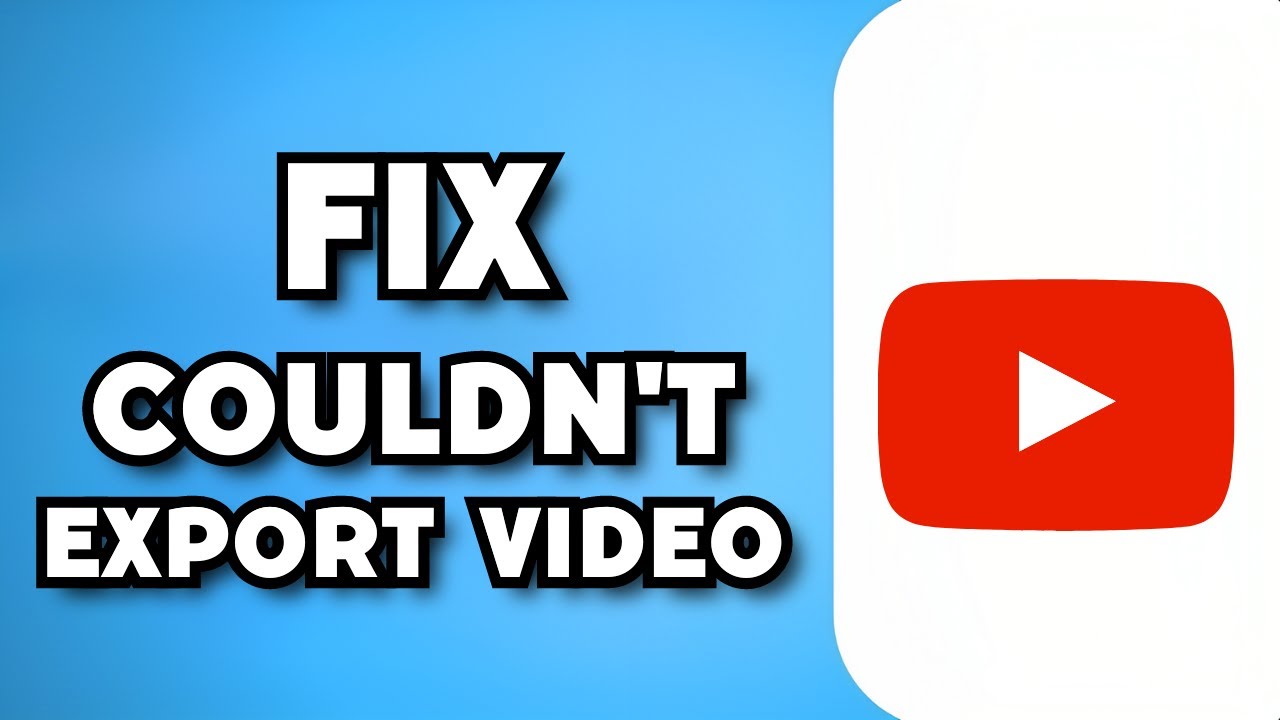Exporting videos to YouTube can sometimes feel like navigating a maze. You’ve worked hard on your content, only to find that your video won't upload or has strange glitches. What gives? Don't worry; you're not alone in this! In this guide, we’ll explore some of the common issues that crop up during video export, and I'll share a few tips to help you resolve them. Let’s dive right in!
Common Causes of Export Problems

When it comes to exporting videos to YouTube, various hurdles can pop up. Understanding the root cause of these issues is key to resolving them effectively. Here are some common causes of export problems:
- File Format Compatibility: YouTube supports specific video formats, such as MP4, AVI, and MOV. If you try to upload a video in an unsupported format, you could run into trouble.
- File Size Limitations: YouTube allows a maximum upload size of 256 GB or 12 hours of video content. If your file exceeds this limit, it won't upload.
- Slow Internet Connection: A slow or unstable internet connection can disrupt the upload process, leading to errors or incomplete uploads.
- Corrupted Video File: If the video file itself is corrupted, it might not export correctly. This can happen during the initial editing or when saving your project.
- Inadequate Hardware Performance: If you're using a computer with limited processing power or RAM, this could slow down rendering and exporting times.
To troubleshoot these issues, start by checking the format and size of your video. Adjusting the settings in your video editing software to comply with YouTube’s requirements can make a world of difference. Once you’ve ruled out these common causes, you can pinpoint further issues as they arise. Happy exporting!
Also Read This: Effective Ways to Block YouTube on Your PC for Enhanced Productivity
Step-by-Step Solutions to Export Issues

Exporting videos to YouTube can sometimes feel like a puzzling task, with various issues cropping up right when you're ready to showcase your content. Luckily, there are some straightforward solutions to help you get your videos uploaded smoothly.
Here’s a handy step-by-step guide to tackle common export issues:
- Check Your File Format:
YouTube supports several formats including MP4, AVI, and MOV. Make sure your video is in one of these formats before attempting to upload.
- Inspect Video Quality:
Is your video resolution too high? YouTube has upload limits based on your account; check if you're exceeding them. Consider lowering the resolution temporarily to see if that solves the issue.
- Update Your Software:
Ensure that the editing software you're using (like Adobe Premiere Pro or Final Cut Pro) is up-to-date. Software updates often resolve bugs that may prevent successful exports.
- Internet Connection:
A weak or unstable internet connection can derail your upload process. Consider using a wired connection or moving closer to your Wi-Fi router for a more stable connection.
- Clear Your Browser Cache:
Sometimes a cluttered browser cache can wreak havoc on video uploads. Clearing it may resolve suddenly stalling uploads.
- Revamp Export Settings:
Check your export settings in your editing software. A good rule of thumb is to set the bitrate to at least 5 Mbps for 1080p video.
- Try a Different Browser:
Run into trouble uploading? Sometimes, simply switching browsers can make a difference. Chrome, Firefox, or Edge—give each a shot!
Also Read This: Adding Transparent Images to Google Slides Easily
Tips to Prevent Future Export Problems
Now that we've tackled how to resolve those pesky export issues, let's chat about how to prevent them from cropping up again. After all, an ounce of prevention is worth a pound of cure, right?
- Stick to Supported Formats:
Always export your videos in one of YouTube's supported formats. This practice can save you time and headache down the line!
- Regularly Clean Up Your Software:
Make it a habit to clean unnecessary files from your editing software. Frequent usage will generate cached files, which can slow down your exports.
- Maintain a Steady Internet Connection:
Investing in a good internet service or having a backup connection can spare you from uploads that sit in limbo.
- Keep Your Hardware Updated:
Your computer might need an upgrade if it’s struggling to handle video exports. Ensure your RAM and disk space are suitable for editing tasks.
- Backup Files Regularly:
Regularly back up your projects. In case of export failure, you won’t have to start from scratch!
By following these tips and steps, you’ll be well on your way to a seamless exporting experience. Happy uploading!
Resolving Video Export Issues on YouTube
YouTube is a powerful platform for sharing videos, but sometimes, users encounter issues when exporting their videos. These problems can stem from various factors, including technical glitches, software limitations, or user errors. Understanding and addressing these issues is essential for ensuring a smooth video export process. Below are some common problems and their solutions.
Common Video Export Issues
- Video Format Compatibility: YouTube supports various formats, but some formats may not work.
- File Size Limits: Exceeding the file size limit (128GB) can prevent successful uploads.
- Slow Upload Speeds: Poor internet connections can lead to long upload times or failed exports.
- Corrupted Files: Files that are damaged or incomplete may not export correctly.
- Encoding Errors: Problems during video encoding can lead to export failures.
Steps to Resolve Export Issues
- Check Video Format: Ensure your video is in a YouTube-supported format (MP4, AVI, MOV).
- Reduce File Size: Use video compression tools to decrease file size without losing quality.
- Improve Internet Speed: Use a wired connection or upgrade your internet plan if needed.
- Repair Corrupt Files: Use video repair software to fix any corrupted files before upload.
- Re-encode Video: Use reliable software to re-encode the video to correct any encoding errors.
By following these steps, users can effectively troubleshoot and resolve common video export issues on YouTube. This will not only enhance the uploading experience but also ensure that content is shared seamlessly.
 admin
admin








